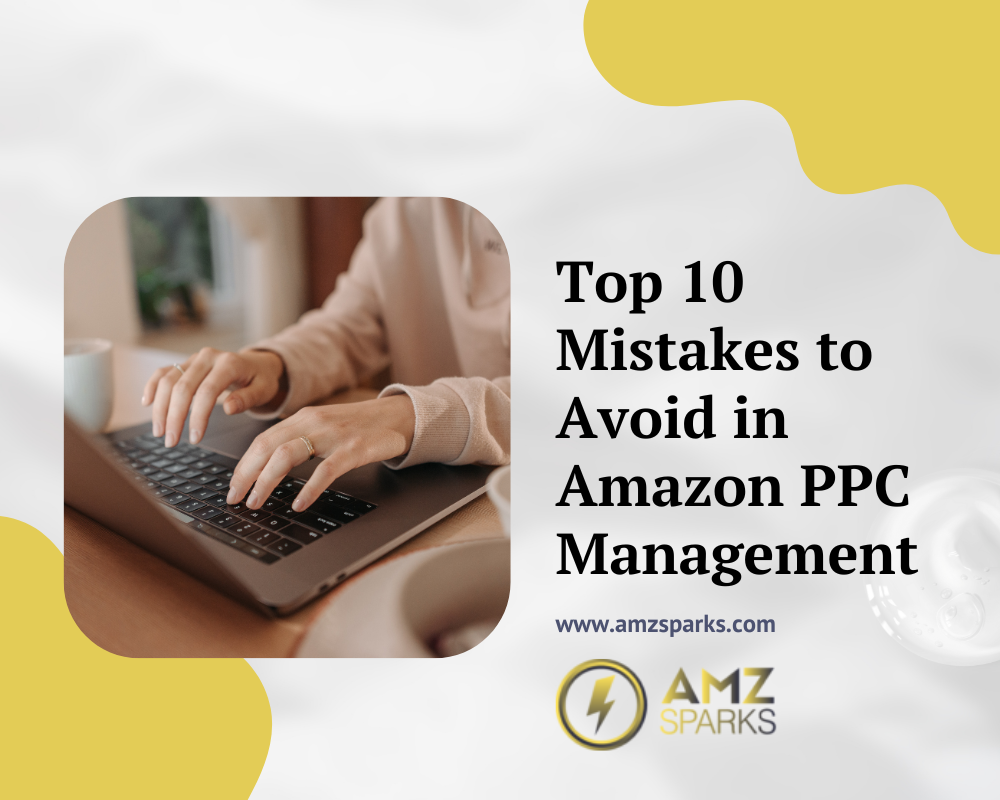Millions of shoppers browse Amazon daily, but what if none of them see your product? This is a common challenge faced by sellers who don't utilize Amazon PPC.
According to online surveys, PPC ads influenced a staggering 89% of Amazon purchases in 2023. This represents a vast pool of potential customers waiting to be tapped into.
However, mistakes can still occur with PPC, often due to a lack of knowledge about Amazon marketing strategies. Here's how to avoid the top 10 mistakes and turn your Amazon business into a success!
In a Nutshell
Our blog delves into the Top 10 Mistakes to Avoid in Amazon PPC Management Services, providing valuable solutions to help your business thrive. You'll learn how to effectively structure campaigns to optimize product listings. Don’t miss the chance to reach your target audience and maximize your ROI. Additionally, if you need expert help with Amazon PPC, contact us today!
Following Flawed Campaign Structure
A well-organized PPC campaign involves categorizing campaigns based on targeting methods such as automatic, manual keyword, and manual ASIN, and grouping products accordingly. This streamlined approach facilitates analysis and allows for precise adjustments in bidding and strategy.
Solution
Invest time in planning your campaign structure upfront. Group products with similar themes or functionalities, and use a naming convention that reflects the campaign’s target audience (e.g., “Headphones_Manual_Keywords”).
Underestimating the Importance of Quality Product Listings
Your product listing is the first thing shoppers see when they click on your ad. Poor listings with low-quality images, incomplete descriptions, and no reviews often deter serious buyers. This is a common mistake among sellers.
Solution
Always use high-quality product photographs and showcase your product from multiple angles. The description should highlight key features and benefits. Provide excellent customer service and post-purchase communication to encourage customer reviews. Remember, a well-optimized listing not only boosts PPC performance but also improves organic ranking.
Setting and Forgetting Campaigns
Amazon pay-per-click requires ongoing attention and monitoring. Launching a powerful Amazon PPC campaign but then neglecting it is like putting your ad budget on autopilot – you might be spending money, but are you reaching the right customers and maximizing your ROI? Neglecting a campaign after launching it can lead to wasted resources.
Solution
Regularly monitor your campaigns. Analyze metrics such as clicks, impressions, conversion rate, and Advertising Cost of Sales (ACOS). Use this data to identify underperforming keywords and adjust bids accordingly. A/B test different ad copy variations to see which resonates best with your target audience. Actively managing your campaigns ensures they continue to deliver optimal results.
Ignoring Competitive Research
Ignoring competitors in Amazon PPC is a major mistake. By not leveraging valuable information from competitors, you miss out on opportunities to improve your campaigns.
When you analyze your competitors, you learn about:
- Keyword Targeting: Which keywords are they bidding on? Are there high-performing keywords you’ve overlooked?
- Bidding Strategies: How aggressively are they bidding on certain keywords? Can you adjust your bids to be more competitive?
- Ad Copywriting: What messaging are they using? Can you learn from their successes or failures to craft more compelling ad copy?
Solution
Utilize reliable Amazon seller tools and third-party resources to analyze your competitors' PPC tactics. Research and testing will refine your strategy and help you identify high-performing keywords you may have missed.
Overlooking A/B Testing
Without A/B testing, you won’t know which of your ads is more effective before investing heavily in them. A/B testing reveals which version of your ad generates more clicks and sales, allowing you to identify what drives visitors to click and buy.
Solution
Create multiple variations of your ad copy with different messaging or visuals. Test these versions side by side to determine which one performs better. Using data from A/B testing helps make informed decisions that attract the right customers and boost sales.
Over-reliance on Auto-Campaigns
Relying too much on auto-campaigns may not yield the best results. Auto-campaigns lack the detailed control needed for optimal performance. They might display your ads for irrelevant keywords or fail to adjust bids for specific products.
Solution
Transition from auto-campaigns to manual campaigns for better control. Manual campaigns allow you to set specific bids for each keyword, ensuring you don’t overspend on clicks that don’t lead to sales. This approach helps avoid wasting money on irrelevant keywords.
Neglecting Negative Keywords and ASINs
Ignoring negative keywords and ASINs can result in your ads appearing in irrelevant searches. Negative keywords prevent your ads from showing up in unrelated searches, and negative ASINs keep your ads from appearing on competing product listings.
Solution
Regularly review your campaign data to identify keywords or ASINs that generate clicks but not conversions. Add these as negative keywords or ASINs to prevent wasted ad spend. Maintaining a well-defined negative keyword list requires consistent monitoring and refinement.
Millions of shoppers browse Amazon daily, but what if none of them see your product? This is a common challenge faced by sellers who don't utilize Amazon PPC.
According to online surveys, PPC ads influenced a staggering 89% of Amazon purchases in 2023. This represents a vast pool of potential customers waiting to be tapped into.
However, mistakes can still occur with PPC, often due to a lack of knowledge about Amazon marketing strategies. Here's how to avoid the top 10 mistakes and turn your Amazon business into a success!
In a Nutshell
Our blog delves into the Top 10 Mistakes to Avoid in Amazon PPC Management Services, providing valuable solutions to help your business thrive. You'll learn how to effectively structure campaigns to optimize product listings. Don’t miss the chance to reach your target audience and maximize your ROI. Additionally, if you need expert help with Amazon PPC, contact us today!
Following Flawed Campaign Structure
A well-organized PPC campaign involves categorizing campaigns based on targeting methods such as automatic, manual keyword, and manual ASIN, and grouping products accordingly. This streamlined approach facilitates analysis and allows for precise adjustments in bidding and strategy.
Solution
Invest time in planning your campaign structure upfront. Group products with similar themes or functionalities, and use a naming convention that reflects the campaign’s target audience (e.g., “Headphones_Manual_Keywords”).
Underestimating the Importance of Quality Product Listings
Your product listing is the first thing shoppers see when they click on your ad. Poor listings with low-quality images, incomplete descriptions, and no reviews often deter serious buyers. This is a common mistake among sellers.
Solution
Always use high-quality product photographs and showcase your product from multiple angles. The description should highlight key features and benefits. Provide excellent customer service and post-purchase communication to encourage customer reviews. Remember, a well-optimized listing not only boosts PPC performance but also improves organic ranking.
Setting and Forgetting Campaigns
Amazon pay-per-click requires ongoing attention and monitoring. Launching a powerful Amazon PPC campaign but then neglecting it is like putting your ad budget on autopilot – you might be spending money, but are you reaching the right customers and maximizing your ROI? Neglecting a campaign after launching it can lead to wasted resources.
Solution
Regularly monitor your campaigns. Analyze metrics such as clicks, impressions, conversion rate, and Advertising Cost of Sales (ACOS). Use this data to identify underperforming keywords and adjust bids accordingly. A/B test different ad copy variations to see which resonates best with your target audience. Actively managing your campaigns ensures they continue to deliver optimal results.
Ignoring Competitive Research
Ignoring competitors in Amazon PPC is a major mistake. By not leveraging valuable information from competitors, you miss out on opportunities to improve your campaigns.
When you analyze your competitors, you learn about:
- Keyword Targeting: Which keywords are they bidding on? Are there high-performing keywords you’ve overlooked?
- Bidding Strategies: How aggressively are they bidding on certain keywords? Can you adjust your bids to be more competitive?
- Ad Copywriting: What messaging are they using? Can you learn from their successes or failures to craft more compelling ad copy?
Solution
Utilize reliable Amazon seller tools and third-party resources to analyze your competitors' PPC tactics. Research and testing will refine your strategy and help you identify high-performing keywords you may have missed.
Overlooking A/B Testing
Without A/B testing, you won’t know which of your ads is more effective before investing heavily in them. A/B testing reveals which version of your ad generates more clicks and sales, allowing you to identify what drives visitors to click and buy.
Solution
Create multiple variations of your ad copy with different messaging or visuals. Test these versions side by side to determine which one performs better. Using data from A/B testing helps make informed decisions that attract the right customers and boost sales.
Over-reliance on Auto-Campaigns
Relying too much on auto-campaigns may not yield the best results. Auto-campaigns lack the detailed control needed for optimal performance. They might display your ads for irrelevant keywords or fail to adjust bids for specific products.
Solution
Transition from auto-campaigns to manual campaigns for better control. Manual campaigns allow you to set specific bids for each keyword, ensuring you don’t overspend on clicks that don’t lead to sales. This approach helps avoid wasting money on irrelevant keywords.
Neglecting Negative Keywords and ASINs
Ignoring negative keywords and ASINs can result in your ads appearing in irrelevant searches. Negative keywords prevent your ads from showing up in unrelated searches, and negative ASINs keep your ads from appearing on competing product listings.
Solution
Regularly review your campaign data to identify keywords or ASINs that generate clicks but not conversions. Add these as negative keywords or ASINs to prevent wasted ad spend. Maintaining a well-defined negative keyword list requires consistent monitoring and refinement.
Setting Restrictive Daily Budgets
Low PPC budgets can limit your ad exposure in a competitive marketplace. When your budget runs out before the day ends, your ads stop showing. This can cause you to miss out on potential conversions.
Solution
Analyze campaign data to understand how quickly your budget is being spent. If budget exhaustion happens consistently, consider a slight increase. However, remember – it’s not just about spending more. Alongside a potential budget increase, explore campaign optimization strategies. This could involve refining keyword targeting or adjusting bids for better performance. The goal is to find a budget that allows your ads to run throughout the day while maintaining profitability.
Lack of an ACOS Target
Operating without a target ACOS leaves you without a benchmark for evaluating campaign effectiveness. ACOS, or Advertising Cost of Sales, measures how much you spend on advertising for every dollar in sales generated. Managing PPC campaigns can become challenging without a clear ACOS target.
Solution
Before launching a campaign, establish a realistic ACOS target based on your product’s profit margin. This target ACOS becomes your guiding principle throughout the campaign. You can make informed bidding adjustments by consistently monitoring your actual ACOS to your target. For instance, if your actual ACOS surpasses your target, consider lowering bids on underperforming keywords. Conversely, a significantly lower ACOS might indicate an opportunity to increase bids and capture even more valuable clicks.

Ignoring Ad Performance Metrics
Metrics like clicks, impressions, and conversion rates tell you how well your ads are doing. If you don’t keep an eye on these numbers, you might miss out on spotting keywords that aren’t working well and are wasting your money.
Solution
Regularly review your campaign data and pinpoint areas needing improvement. For instance, a high number of impressions with a low click-through rate (CTR) could indicate poorly targeted keywords that aren’t resonating with your audience. You can change your bids or get rid of useless keywords by finding these problems.
Key Takeaways
Don’t let your amazing products get lost in the Amazon abyss! This blog unpacked the top 10 mistakes to dodge in Amazon PPC management, helping you to take control and optimize your campaigns for success.
We explored the importance of a well-structured campaign layout, clear product listings and the importance of ongoing monitoring and adjusting campaigns.
For better results, do the A/B testing to gain valuable insights. Remember, a strategic approach that balances budget allocation with ACOS targets is key.
Closely analyze ad performance metrics and continuously refine your campaigns to maximize your return on investment.
Need help with Amazon PPC? Our expert Amazon PPC management services can help you navigate the complexities and achieve outstanding results. Contact us today, and let’s transform your Amazon business into a thriving success story!
FAQ
What Are Amazon PPC Ads, and How Can Amazon PPC Management Services Help?
Amazon PPC (Pay-Per-Click) is a simple marketing hack to attract more buyers online. However, it is (paid). These ads simply enable you to bid on keywords relevant to your products, paying only when users click on your ad. Amazon PPC Management services, provided by Amazon PPC Experts, assist in optimizing these campaigns for maximum efficiency and profitability.
Why Should I Consider Investing in Amazon PPC Management Services?
Using Amazon PPC Management services ensures that your PPC campaigns are expertly managed for optimal results.
How Does PPC on Amazon Impact FBA Businesses?
PPC on Amazon is the most reliable option for FBA (Fulfillment by Amazon) businesses. It can drive targeted traffic to your listings. FBA sellers must opt for PPC ads to increase their product rankings, outperform competitors, and ultimately grow their business on Amazon through Amazon PPC Ads.
What Are Some Strategies for Effective Amazon PPC Management?
Effective Amazon PPC management involves comprehensive keyword research, strategic bid management, and regular performance monitoring. Amazon PPC Experts recommend optimizing product listings, testing different ad creatives, and staying updated with Amazon’s advertising policies for maximum success.
Why Invest in AMZSparks’ Amazon PPC Management Services?
Leave the complexities of PPC to us! AMZSparks guarantees your campaigns are expertly managed, reaching the right audience and driving sales. We’ll optimize your ads for peak performance, letting you focus on running your business.






Comments